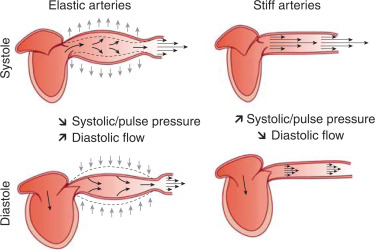 |
|
Arterial stiffness measured, with a specially equipped blood pressure cuff, predicted the development of glaucoma and could potentially be used in clinical practice, this research suggests. Photo: Briet M, et al. Kidney Int. 2012. 82:388-400. Click image to enlarge. |
Although clinicians mostly focus on the role of intraocular pressure (IOP) in the development of glaucoma, systemic blood pressure also plays an important role, particularly in the normal tension form where IOP is less of a direct factor. The vascular theory of glaucoma “stipulates that at least some glaucoma may result from damage to the optic nerve caused by low or fluctuating ocular blood flow,” writes a group of researchers from New Zealand, the UK and Austria in a new paper appearing in American Journal of Ophthalmology.
The team set out to explore potential associations between arterial stiffness and glaucoma in a prospective, population-based cohort study. Arterial stiffness can be measured in several ways, and for these purposes the team used pulse wave velocity (PWV) measurement, “a measure of the speed at which a forward pressure wave propagates in an artery, with higher measures indicating increased arterial stiffness.” the AJO paper explains. Some blood pressure cuffs are equipped with the capability to measure PWV.
Arterial stiffness was assessed in 4,713 participants between the ages of 50 and 84 without known glaucoma by way of aortic, carotid-femoral PWV and aortic pulse pressure with a follow-up of 10.5 years. Incident glaucoma was identified through linkage to national prescription and hospital discharge registers. Relative risks of glaucoma for each arterial stiffness measure were estimated.
It was found that higher arterial stiffness was associated with incident glaucoma, with a significant positive trend in glaucoma incidence for each arterial stiffness measure.
The increase in rate of glaucoma incidence with PWV findings is consistent with other cross-sectional studies, the researchers noted. One found a stepwise increase in carotid-femoral PWV from healthy individuals compared to those with POAG and pseudoexfoliative glaucoma, and another found there was a positive trend linking brachial-ankle PWV and glaucoma.
The vascular theory, which attempts to explain glaucoma causation on the basis of reduced perfusion pressure, argues that frequent ischemia and reperfusion to the optic nerve may cause injury. “Consistent with this theory is the recognition that increased arterial stiffness may impact on organs with high blood flow and low vascular resistance such as the eyes,” the authors explained. “As a consequence of increased pulsatility, the small vessels of the eye may undergo smooth muscle hypertrophy resulting in arteriolar narrowing, increased microvascular resistance and reduced vessel density.”
A previous study—which found PWV was a predictor of POAG progression and used OCT to document that participants with higher PWV tended to have lower macular vessel density—supported this theory. Other studies using fundus photography have further shown associations of both aortic and brachial-ankle PWV with central retinal arteriolar narrowing, the authors added.
The excessive pulsatility of blood generated by increased arterial stiffness may also damage the microvasculature of the eye, they suggest, resulting in the tearing of endothelial and smooth muscle cells. “It is possible, however, that given the distance the pulse must travel from the aorta to the eye that pulsatility may be sufficiently dampened by more distal vessels.”
Interpreting this study’s results in the context of the vascular theory suggests that reduction of arterial stiffness using oral medications could be a new therapeutic for glaucoma, as various antihypertensive drugs have been found to be effective in reducing PWV in people with hypertension, the researchers proposed.
Beros AL, Sluyter JD, Hughes AD, et al. Arterial stiffness and incident glaucoma: a large population-based cohort study. May 13, 2024. [Epub ahead of print.] |


